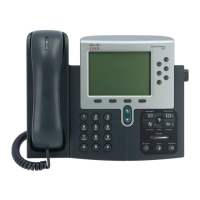9-17
Cisco Unified IP Phone Administration Guide for Cisco Unified Communications Manager 7.1
OL-18913-01
Chapter 9 Troubleshooting and Maintenance
Where to Go for More Troubleshooting Information
Troubleshooting Tips
When you observe significant and persistent changes to metrics, use Table 9-5 for general
troubleshooting information:
Note Voice quality metrics do not account for noise or distortion, only frame loss.
Where to Go for More Troubleshooting Information
If you have additional questions about troubleshooting the Cisco Unified IP Phones, several Cisco.com
web sites can provide you with more tips. Choose from the sites available for your access level.
• Cisco Unified IP Phone Troubleshooting Resources:
http://www.cisco.com/en/US/products/hw/phones/ps379/tsd_products_
support_series_home.html
• Cisco Products and Services (Technical Support and Documentation):
http://www.cisco.com/en/US/products/sw/voicesw/tsd_products_support_
category_home.html
Table 9-5 Changes to Voice Quality Metrics
Metric Change Condition
MOS LQK scores decrease
significantly
Network impairment from packet loss or high jitter:
• Average MOS LQK decreases could indicate widespread
and uniform impairment.
• Individual MOS LQK decreases indicate bursty
impairment.
Cross-check with Conceal Ratio and Conceal Seconds for
evidence of packet loss and jitter.
MOS LQK scores decrease
significantly
• Check to see if the phone is using a different codec than
expected (RxType and TxType).
• Check to see if the MOS LQK version changed after a
firmware upgrade.
Conceal Ratio and Conceal
Seconds increase significantly
• Network impairment from packet loss or high jitter.
Conceal Ratio is near or at zero,
but the voice quality is poor.
• Noise or distortion in the audio channel such as echo or
audio levels.
• Tandem calls that undergo multiple encode/decode such as
calls to a cellular network or calling card network.
• Acoustic problems coming from a speakerphone,
handsfree cellular phone or wireless headset.
Check packet transmit (TxCnt) and packet receive (RxCnt)
counters to verify that voice packets are flowing.

